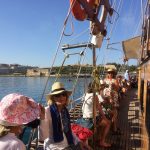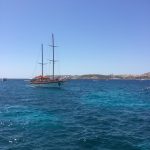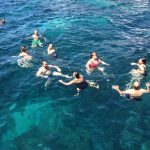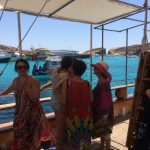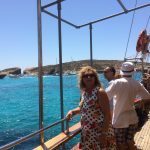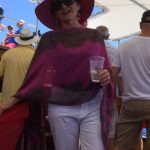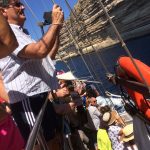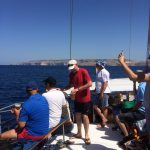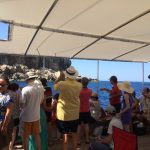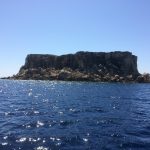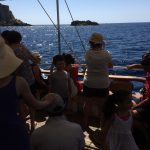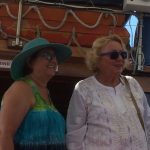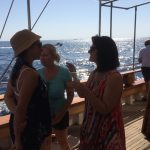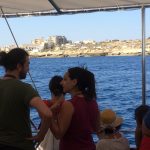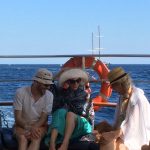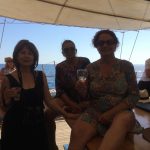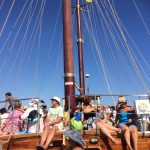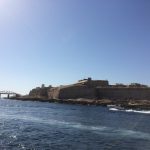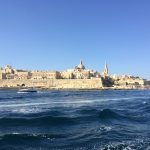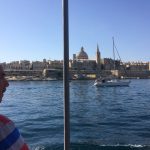Filfla Up Close + Round Malta Cruise
Report and photos with thanks to Maura Marlow.
On Sunday 21st August, FAA members were fortunate once again to set sail, this time on the beautiful sailing ship Hera 2. This summer cruise is now an established event in the calendar, thanks to the magnanimous response from our members and friends every year.
This year the gods smiled on us as the sun shone and the light breeze predicted a calm and gentle sail. The FAA volunteers arrived early to ensure a smooth check in and this, along with Captain Steve allowing us to board early, got the whole day out off to a great start.

We set off with a group of about 180 excited and happy passengers, eager to take a different route from the usual east coast sail to Comino. Our course was plotted to sail south and round the southern tip of Malta and head up the west coast to take a close look at Filfla, and then on to Comino for a few hours of swimming in the Blue Lagoon before heading back to Sliema.
The Hera 2 provided ample space for everyone to find a comfortable space inside or out, to sit or lounge and sunbathe, or to meander and have a chat or to take photos of the amazing landscapes, particularly of Filfla and the west coast cliffs.
Like last year, we had the advantage of having our guest speakers Arnold and Jeffrey Sciberras, who between them enlightened and entertained us with their expert knowledge on the geology, the rock feature formations, the flora and fauna and the evolutionary history of these features. Astrid Vella again complemented the Sciberras brothers by giving us a wonderfully well-informed running commentary on the history of the harbours, of Valletta, and of the many towers and ancient monuments we were privileged to view from a different perspective as we sailed along. We had the opportunity to observe how Malta itself is changing as man makes his impact on our coastal areas.
A highlight of the trip was a close look at the island of Filfla, a restricted area, dangerous with unexploded shells left from when the Royal Navy and the Royal Air Force used it as target practice. We circled the island gazing at the vertical cliffs on the western side showing how fractured and dangerous it is, with huge rocks ready to plunge into the sea. We learned how once there was a small chapel, built by local fishermen in 1343, and how in 1856 a strong earthquake destroyed half of Filfla and the chapel. And because it is a restricted island the flora and fauna has thrived so the European Storm Petrel, Cory’s Shearwater and the Yellow-legged Gull breed there under protection. This isolation has also allowed an endemic species of lizard to breed there; but contrary to popular belief the lizards do not have two tails!
As we circled Filfla we could see the prehistoric sites of Ħagar Qim and Mnajdra on the mainland facing Filfla. We were reminded of the Congreve Memorial placed facing the sea, dedicated to Sir Walter Norris Congreve, the British Governor of Malta who requested to be buried mid-way between the coast and Filfla in 1927.
Our trip continued skirting the dramatic Upper Coralline Limestone cliffs of western Malta, a close look at the remarkable geology of these vertical formations and boulder screes, a home to a wide range of plants and animals, such as the Maltese Rock-centaury, the Maltese Salt tree and the Maltese Sea-Lavander, garigue, maquis, andendemic snails and seabirds. It was noticeable how different this west coast is to the more built-up east coast, probably because the towering cliffs here prevented much development.

It was nearing lunch time as we rounded the north coast and a very well-organised crew called us to the buffet lunch of chicken, a selection of salads, roast potatoes and side dishes, plenty to satisfy our hunger from all that fresh air! The atmosphere now was filled with laughter, chat, oohs and ahhs as we spotted something else of interest. People began to stir to check they had everything they needed for our next destination: …Comino
The Blue Lagoon was filled with boats of every size and shape, music and noise reaching our ears as we approached, reminding us that the party had started! We dropped anchor and almost immediately people were in the water. Some of the braver ones jumped in from a height, others slid in from the ladders, and some watched from on board or took a walk to the mainland. We had a few hours here to relax, snooze or read, or chat with our local and international members and holidaymakers who were inspired to take this cruise.
By 4 p.m. we were heading back. A shout went up as someone spotted some bottlenose dolphins near the fish farms. A lovely memory to take home! As we sailed past the northern coast, Astrid continued to keep us informed about the De Redin towers along this coast, pointing out the Red Tower from 1649 and later the pentagonal Fort Madalena, part of the Victoria Lines well hidden in the cliffs. The much gentler coastline and formations allowed us to see Mellieħa perched high above its large bay, probably named after the word “mehl” for “salt”. The fascinating fact about these ancient Punic-Roman saltpans in Mellieħa Bay is that each was so precisely made, varying by about only half centimeter in size!
Our cruise was almost at an end as we sailed past Pembroke, noting the derelict White Rocks complex overlooking the garigue, past the skyscrapers of St Julian’s and on to Sliema. Everyone was still enjoying the calm sea, the gentle breeze, and the late afternoon sun, taking a few last photos of a superb day out!
We have to thank Captain Steve and his crew who made our day such a pleasurable one. We wouldn’t have had such a fantastic insight into the geological, flora and fauna and environmental facets of Malta without Arnold and Jeffrey Sciberras. And without Astrid’s phenomenal facts and details on our cultural history, it would have been just another cruise! We also thank our members and friends who support us. And, lastly, thanks to our volunteers who generously give their time to make such events happen!
You can follow Arnold and Jeffrey Sciberras’ work on endemic Maltese wildlife here, or click here to learn more about their work on Maltese domesticated species.
If you are curious to find out more about Filfla, click here.
The event was supported by Mizzi Motors, Dhalia Ltd, Firstbridge and St James Hospital.










